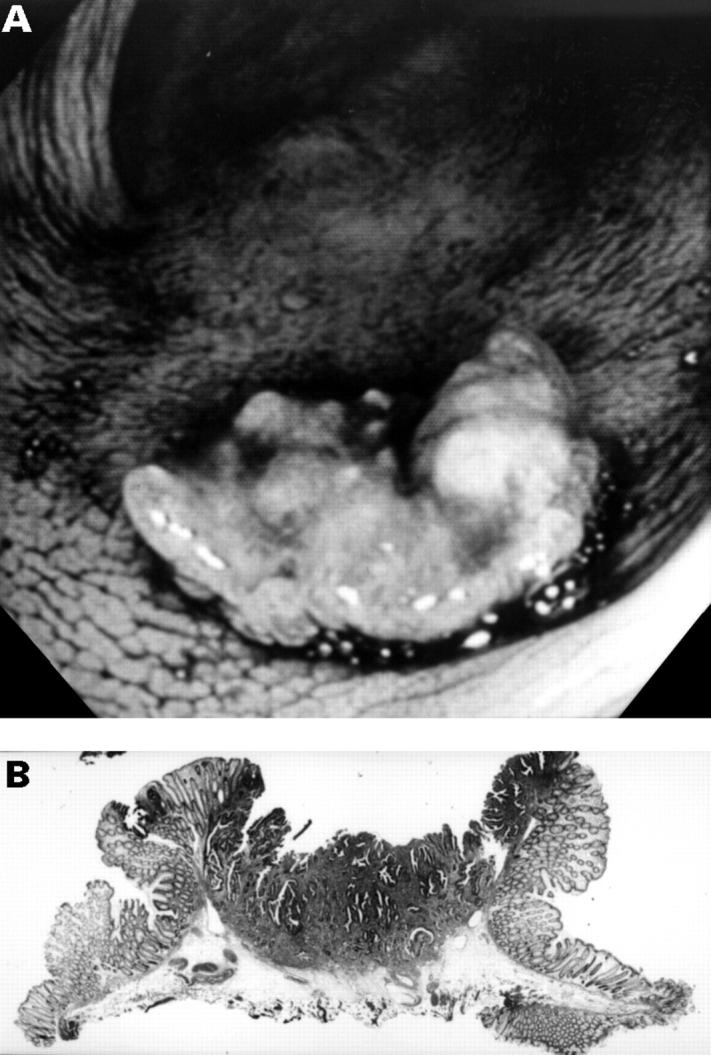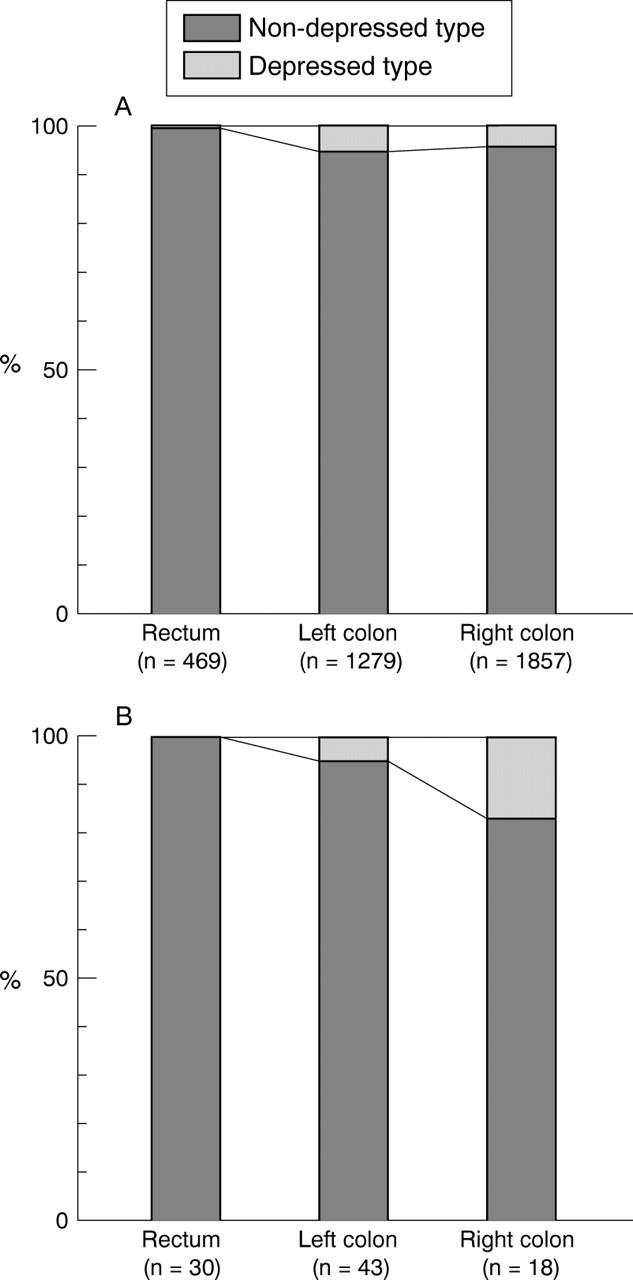Abstract
BACKGROUND—There is a difference in the location of colorectal mucosal lesions and invasive cancers. AIMS—To ascertain whether the location of colorectal neoplasms reflects the carcinogenesis pathway. METHODS—The subject material consisted of 4147 neoplastic lesions that had been resected endoscopically or surgically from 5025 patients. Mucosal lesions and submucosal cancers were classified into depressed and non-depressed types endoscopically or histologically. The relations between macroscopic type, size, histology, and location were investigated. RESULTS—(a) Non-depressed type. A total of 1774 of 3454 (51%) mucosal lesions were located in the right colon, 1212 (35%) in the left colon, and 468 (14%) in the rectum. The incidence of mucosal lesions larger than 10 mm was 10% (185/1774) in the right colon, 21% (254/1212) in the left colon, and 27% (127/468) in the rectum. The incidence of mucosal lesions with villous components was 2% (32/1774) in the right colon, 5% (63/1212) in the left colon, and 13% (62/468) in the rectum. The ratio of submucosal cancers to mucosal lesions was significantly higher in the rectum (0.064, 30/469) than in the left (0.034, 43/1279) or right (0.010, 18/1857) colon. (b) Depressed type. The incidences of depressed type mucosal lesions and submucosal cancers were 5% (83/1857) and 17% (3/18) in the right colon, 5% (67/1279) and 5% (2/43) in the left colon, and 0.2% (1/469) and 0% (0/30) in the rectum, respectively. CONCLUSION—There may be some mechanisms that promote the progression of mucosal lesions to invasive cancers in the left colon and rectum, whereas a de novo pathway from depressed type lesions may be implicated in some cancers of the right colon. Keywords: colorectal cancer; depressed cancer; carcinogenesis
Full Text
The Full Text of this article is available as a PDF (104.7 KB).
Figure 1 .

Morphological appearance of the depressed type of submucosal cancer. (A) Endoscopy shows a depressed cancer 11 mm diameter in size; (B) in the cross section of this lesion, the edge is depressed compared with the surrounding normal mucosa.
Figure 2 .

Comparison of the incidence of depressed and non-depressed types of neoplastic lesion in the rectum, left colon and right colon. (A) Mucosal lesions; (B) submucosal cancers. A significant difference in the macroscopic type was noted between the rectum and colon (p<0.001). The incidence of depressed submucosal cancers in the right colon was significantly higher than that in the rectum (p = 0.0472).
Figure 3 .

(A) Relation between the location and size of non-depressed mucosal lesions. (B) Relation between the location and incidence of villous components in the non-depressed mucosal lesions. (C) Location of mucosal lesions and submucosal cancers.
Selected References
These references are in PubMed. This may not be the complete list of references from this article.
- Adachi M., Muto T., Okinaga K., Morioka Y. Clinicopathologic features of the flat adenoma. Dis Colon Rectum. 1991 Nov;34(11):981–986. doi: 10.1007/BF02049961. [DOI] [PubMed] [Google Scholar]
- Atkin W. S., Morson B. C., Cuzick J. Long-term risk of colorectal cancer after excision of rectosigmoid adenomas. N Engl J Med. 1992 Mar 5;326(10):658–662. doi: 10.1056/NEJM199203053261002. [DOI] [PubMed] [Google Scholar]
- Baker S. J., Fearon E. R., Nigro J. M., Hamilton S. R., Preisinger A. C., Jessup J. M., vanTuinen P., Ledbetter D. H., Barker D. F., Nakamura Y. Chromosome 17 deletions and p53 gene mutations in colorectal carcinomas. Science. 1989 Apr 14;244(4901):217–221. doi: 10.1126/science.2649981. [DOI] [PubMed] [Google Scholar]
- Bedenne L., Faivre J., Boutron M. C., Piard F., Cauvin J. M., Hillon P. Adenoma--carcinoma sequence or "de novo" carcinogenesis? A study of adenomatous remnants in a population-based series of large bowel cancers. Cancer. 1992 Feb 15;69(4):883–888. doi: 10.1002/1097-0142(19920215)69:4<883::aid-cncr2820690408>3.0.co;2-b. [DOI] [PubMed] [Google Scholar]
- Bos J. L., Fearon E. R., Hamilton S. R., Verlaan-de Vries M., van Boom J. H., van der Eb A. J., Vogelstein B. Prevalence of ras gene mutations in human colorectal cancers. 1987 May 28-Jun 3Nature. 327(6120):293–297. doi: 10.1038/327293a0. [DOI] [PubMed] [Google Scholar]
- Bufill J. A. Colorectal cancer: evidence for distinct genetic categories based on proximal or distal tumor location. Ann Intern Med. 1990 Nov 15;113(10):779–788. doi: 10.7326/0003-4819-113-10-779. [DOI] [PubMed] [Google Scholar]
- Delattre O., Olschwang S., Law D. J., Melot T., Remvikos Y., Salmon R. J., Sastre X., Validire P., Feinberg A. P., Thomas G. Multiple genetic alterations in distal and proximal colorectal cancer. Lancet. 1989 Aug 12;2(8659):353–356. doi: 10.1016/s0140-6736(89)90537-0. [DOI] [PubMed] [Google Scholar]
- DiSario J. A., Foutch P. G., Mai H. D., Pardy K., Manne R. K. Prevalence and malignant potential of colorectal polyps in asymptomatic, average-risk men. Am J Gastroenterol. 1991 Aug;86(8):941–945. [PubMed] [Google Scholar]
- Fujii T., Rembacken B. J., Dixon M. F., Yoshida S., Axon A. T. Flat adenomas in the United Kingdom: are treatable cancers being missed? Endoscopy. 1998 Jun;30(5):437–443. doi: 10.1055/s-2007-1001304. [DOI] [PubMed] [Google Scholar]
- Fujimori T., Satonaka K., Yamamura-Idei Y., Nagasako K., Maeda S. Non-involvement of ras mutations in flat colorectal adenomas and carcinomas. Int J Cancer. 1994 Apr 1;57(1):51–55. doi: 10.1002/ijc.2910570110. [DOI] [PubMed] [Google Scholar]
- Gillespie P. E., Chambers T. J., Chan K. W., Doronzo F., Morson B. C., Williams C. B. Colonic adenomas--a colonoscopy survey. Gut. 1979 Mar;20(3):240–245. doi: 10.1136/gut.20.3.240. [DOI] [PMC free article] [PubMed] [Google Scholar]
- Hermanek P., Frühmorgen P., Guggenmoos-Holzmann I., Altendorf A., Matek W. The malignant potential of colorectal polyps--a new statistical approach. Endoscopy. 1983 Jan;15(1):16–20. doi: 10.1055/s-2007-1018598. [DOI] [PubMed] [Google Scholar]
- Iishi H., Kitamura S., Nakaizumi A., Tatsuta M., Otani T., Okuda S., Ishiguro S. Clinicopathological features and endoscopic diagnosis of superficial early adenocarcinomas of the large intestine. Dig Dis Sci. 1993 Jul;38(7):1333–1337. doi: 10.1007/BF01296086. [DOI] [PubMed] [Google Scholar]
- Iishi H., Tatsuta M., Tsutsui S., Imanishi K., Otani T., Okuda S., Ishiguro S., Taniguchi H. Early depressed adenocarcinomas of the large intestine. Cancer. 1992 May 15;69(10):2406–2410. doi: 10.1002/1097-0142(19920515)69:10<2406::aid-cncr2820691004>3.0.co;2-e. [DOI] [PubMed] [Google Scholar]
- Kaneko K., Fujii T., Kato S., Boku N., Oda Y., Koba I., Ohtsu A., Hosokawa K., Ono M., Shimoda T. Growth patterns and genetic changes of colorectal carcinoma. Jpn J Clin Oncol. 1998 Mar;28(3):196–201. doi: 10.1093/jjco/28.3.196. [DOI] [PubMed] [Google Scholar]
- Kudo S. Endoscopic mucosal resection of flat and depressed types of early colorectal cancer. Endoscopy. 1993 Sep;25(7):455–461. doi: 10.1055/s-2007-1010367. [DOI] [PubMed] [Google Scholar]
- Kuramoto S., Oohara T. Flat early cancers of the large intestine. Cancer. 1989 Aug 15;64(4):950–955. doi: 10.1002/1097-0142(19890815)64:4<950::aid-cncr2820640430>3.0.co;2-o. [DOI] [PubMed] [Google Scholar]
- Kuramoto S., Oohara T. Minute cancers arising de novo in the human large intestine. Cancer. 1988 Feb 15;61(4):829–834. doi: 10.1002/1097-0142(19880215)61:4<829::aid-cncr2820610431>3.0.co;2-p. [DOI] [PubMed] [Google Scholar]
- Lane N. The precursor tissue of ordinary large bowel cancer. Cancer Res. 1976 Jul;36(7 Pt 2):2669–2672. [PubMed] [Google Scholar]
- Lescher T. C., Dockerty M. B., Jackman R. J., Beahrs O. H. Histopathology of the larger colonic polyp. Dis Colon Rectum. 1967 Mar-Apr;10(2):118–124. doi: 10.1007/BF02617358. [DOI] [PubMed] [Google Scholar]
- Minamoto T., Sawaguchi K., Mai M., Yamashita N., Sugimura T., Esumi H. Infrequent K-ras activation in superficial-type (flat) colorectal adenomas and adenocarcinomas. Cancer Res. 1994 Jun 1;54(11):2841–2844. [PubMed] [Google Scholar]
- Morson B. C. Precancerous and early malignant lesions of the large intestine. Br J Surg. 1968 Oct;55(10):725–731. doi: 10.1002/bjs.1800551003. [DOI] [PubMed] [Google Scholar]
- Muto T., Bussey H. J., Morson B. C. The evolution of cancer of the colon and rectum. Cancer. 1975 Dec;36(6):2251–2270. doi: 10.1002/cncr.2820360944. [DOI] [PubMed] [Google Scholar]
- Muto T., Kamiya J., Sawada T., Konishi F., Sugihara K., Kubota Y., Adachi M., Agawa S., Saito Y., Morioka Y. Small "flat adenoma" of the large bowel with special reference to its clinicopathologic features. Dis Colon Rectum. 1985 Nov;28(11):847–851. doi: 10.1007/BF02555490. [DOI] [PubMed] [Google Scholar]
- O'Brien M. J., Winawer S. J., Zauber A. G., Gottlieb L. S., Sternberg S. S., Diaz B., Dickersin G. R., Ewing S., Geller S., Kasimian D. The National Polyp Study. Patient and polyp characteristics associated with high-grade dysplasia in colorectal adenomas. Gastroenterology. 1990 Feb;98(2):371–379. [PubMed] [Google Scholar]
- Shimoda T., Ikegami M., Fujisaki J., Matsui T., Aizawa S., Ishikawa E. Early colorectal carcinoma with special reference to its development de novo. Cancer. 1989 Sep 1;64(5):1138–1146. doi: 10.1002/1097-0142(19890901)64:5<1138::aid-cncr2820640529>3.0.co;2-a. [DOI] [PubMed] [Google Scholar]
- Vogelstein B., Fearon E. R., Hamilton S. R., Kern S. E., Preisinger A. C., Leppert M., Nakamura Y., White R., Smits A. M., Bos J. L. Genetic alterations during colorectal-tumor development. N Engl J Med. 1988 Sep 1;319(9):525–532. doi: 10.1056/NEJM198809013190901. [DOI] [PubMed] [Google Scholar]
- Wolber R. A., Owen D. A. Flat adenomas of the colon. Hum Pathol. 1991 Jan;22(1):70–74. doi: 10.1016/0046-8177(91)90064-v. [DOI] [PubMed] [Google Scholar]
- Yamagata S., Muto T., Uchida Y., Masaki T., Sawada T., Tsuno N., Hirooka T. Lower incidence of K-ras codon 12 mutation in flat colorectal adenomas than in polypoid adenomas. Jpn J Cancer Res. 1994 Feb;85(2):147–151. doi: 10.1111/j.1349-7006.1994.tb02075.x. [DOI] [PMC free article] [PubMed] [Google Scholar]


